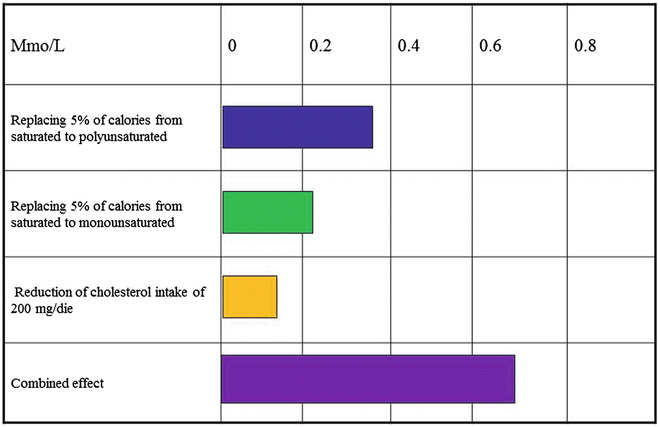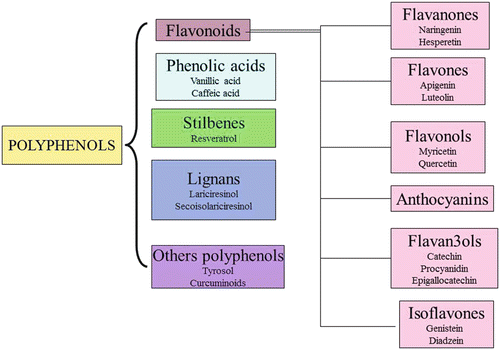Fig. 14.1
Trans-fatty acids and atherosclerotic effects
Increasing evidence in the literature shows that adequate dietary intake (between 4 and 8% of total calories) of omega 6, in particular, linoleic acid, is useful in reducing cardiovascular risk. Increasing intake of omega 6 is associated with decreased concentrations of plasma LDLs and triglycerides and increased concentrations of high-density lipoproteins (HDLs) without unfavorable evidence for arterial inflammation markers and arterial pressure and hemostasis parameters. Simple replacement of 5% of the calories from saturated fat with omega 6 causes a reduction of serum cholesterol greater than is obtained by drastically reducing dietary cholesterol (Fig. 14.2). A recent study [4] showed that the substitution of saturated fats with polyunsaturated fats entails a reduction in coronary risk; replacement with simple carbohydrates is associated with an increased risk, whereas with complex carbohydrates this risk is reduced. We cannot merely rely on a single risk marker because, if we consider the effect on HDL cholesterol, all fatty acids increase this protective parameter, especially saturated fats.


Fig. 14.2
Reduction in serum cholesterol due to substitution of saturated intake with polyunsaturated or monounsaturated or intake of dietary cholesterol reduction. Source: Clarke R, Frost C, Collins R et al. Dietary lipids and blood cholesterol: quantitative meta-analysis of metabolic ward studies. BMJ 1997;314:112–117
Omega-3s have a known cardioprotective effect. In 1975, Sinclair observed a low incidence of heart attack and consumption of foods high in omega 3 consumption in the population of Greenland. The protective effect appears to be due to reduced synthesis and secretion of VLDL and increased clearance of plasma triglycerides and an anti-arrhythmic effect. They also have a positive effect on blood pressure, platelet aggregation, endothelial dysfunction, and systemic inflammation [5]. Omega-3s have a dose-dependent effect on the level of triglycerides, and the recommended dose is 2–3 g/day. Studies have shown a 25–52% reduction in plasma triglyceride levels.
14.2.1 Phythosterols
Phythosterols are substances naturally present in many foods, including nuts, almonds, dried fruit, cereals, vegetables (pulses), and olive oil.
Of the phytosterols identified (at least 40 types), those most frequently present in food are beta-sitosterol (50%), campesterol (33%), and stigmasterol (4%).
Phytosterols are structurally similar to human cholesterol and present poor intestinal absorption. They cannot be synthesized endogenously and are derived exclusively from the diet or are added to foods such as yogurt, margarine, sauces, and cream cheeses. Two grams per day of phytosterols have been shown to reduce LDL by about 7–10%.
Three grams per day should not be exceeded, in combination with a diet rich in vegetables and fruits, to balance the reduced blood levels of beta-carotene.
Phythosterols should not be used in:
Pregnant and lactating women
Children under the age of 5 years
There are limited data about the effect on risk factors for atherosclerosis and no major randomized cardiovascular outcomes data [6].
14.2.2 Polyphenols and Flavonoids
The term polyphenols refers to many classes of compounds with a common chemical structure, derived from benzene with one or more hydroxyl groups associated with the benzene ring. This makes these materials excellent scavengers. The high intake by diet of these compounds leads to the high reduction (50%) in cardiovascular mortality [7].
14.3 Resveratrol
Resveratrol is a polyphenol that belongs to the class of stilbenes present in small quantities in blackberries, grapes, peanuts, and red wine. Its mechanism of action seems to be the activation of SIRT1 deacetylase (silent mating type information regulation 2 homolog 1), a protein involved in the modulation of glucose and lipid metabolism and cell survival mechanisms. Studies are increasingly highlighting the power to reduce the chronic inflammation that predisposes to many diseases. Testing, whether with a low dose (8 mg) or a high dose (5 g) did not reveal any significant adverse events. Timmers et al. [10], in a study of obese individuals showed an improvement in the metabolic profile, the inflammatory status, blood pressure, and initial liver damage. Benefits for secondary cardiovascular prevention have also been shown [11].
14.4 Soy
From the botanical terms, the soy plant (Glycine max L. Merr.) belongs to the legume family with a high protein content (high biological value proteins), and rich in lipids and minerals (potassium calcium, phosphorus).
In the group of lipids, phosphatidylcholine is known as soy lecithin, which is the raw material of cell structures and contributes in part to reducing the levels of serum cholesterol to synergistic action with all the other constituents of the legume, such as protein, isoflavones (which behave as phytoestrogens), fibers, and saponins [12, 13].
Soybeans, because of the presence of phytoestrogens (genistein), interact with warfarin and tamoxifen and should be contraindicated in patients with estrogen-dependent tumors. Absolute caution must be applied when in constant use during childhood and adolescence because they may lead to the disorders of sexual development and somatic interference in the hypothalamic–pituitary–gonadal axis, with alterations to the sexual cycle. Furthermore, genistein inhibits the activity of cytochrome CYP3A4.
14.5 Bergamot and Bergamot Polyphenolic Fraction
Bergamot is a citrus fruit of the genus Citrus (Citrus bergamia Risso), belonging to the family Rutaceae, with a high content of flavonoids and flavonoid glycosides, especially naringenin and hesperetin. These compounds are absorbed by the small intestine and are hydrolyzed at the level of colon microflora in aglycones and aromatic acids. The bergamot polyphenols can activate AMP kinase (a regulator of glucose metabolism and fatty acids) or inhibit hydroxymethyl-coenzyme A (HMG-CoA) reductase (statin-like action). In popular tradition, bergamot was used as a neuro-sedative, antiseptic, and clinical bacteriostatic. Several studies have shown that the polyphenol fraction of bergamot (BPF) is effective at reducing total cholesterol, LDL, triglycerides, and glucose [14] and potentiates the effect of rosuvastatin in improving the lipid profile [15].
14.6 Curcuma longa L. (Zingiberaceae)
Turmeric is a herbaceous, rhizomatous, perennial native to the Far East and Australia, and Curcuma longa L. (also known by the name of Curcuma domestica Val.) is the most common species from which, after boiling and drying, the spice obtained is used, especially in Indian cooking. The rhizome, in addition to food use, is prescribed for its choleretic and cholagogue effects in functional disorders of the digestive processes attributable to the liver.
The main elements are the curcuminoids (which account for 3–5% of the drug), a mixture among which curcumin is the most abundant.
The main biological effects attributed to turmeric and curcumin are anti-oxidant, anti-inflammatory, anti-tumor, hepatoprotective, and hypolipidemic [16]. These effects are enhanced in combination with a substance of natural origin, piperine, which represents the main constituent of pepper. Serum levels of curcumin, when taken alone, are usually very low or undetectable; however, by means of a clinical study, carried out in eight healthy subjects, an increase in the curcumin bioavailability following joint administration of curcumin (2 g) and piperine (20 mg) was observed. This suggests that piperine might be beneficial to both the absorption and, consequently, its biological effects, also found in rats, in which it was shown that the concomitant use of these two substances enhances the cholesterol-lowering activity of curcumin itself. It is reasonable to hypothesize that cholesterol reduction is attributable to an increase in the bioavailability of curcumin; therefore, such a combination could represent a valuable contribution in the treatment of hyperlipidemia [17].
14.6.1 Phytotherapy
Until the advent of new drugs of plant origin acting like statins (Monascus ruber) and rebalancing the lipemic state (policosanol from sugarcane), herbal medicine benefitted from therapeutic agents that are still effective, even if they have been replaced with new protocols. In fact, in addition to excessive lipid intake, this condition can also be due to increased endogenous triglyceride synthesis in the liver or to insufficient exogenous elimination. In that case, we use hepatoprotective and choleretic–cholagogue function and balance hepatobiliary and intestinal functionality.
Cynara scolymus
Taraxacum officinale
Silybum marianum
Peumus boldus
Rosmarinus officinalis
Other herbal remedies are used, resources still valid, even if they have been superseded by new protocols:
Olea europae: the glycerin macerate Olivo, traditionally used as a hypolipidemic remedy.
Cynara scolymus: artichoke, for its action as a cholagogue and laxative, is useful in hypercholesterolemia because it helps to remove bile salts via the bile and stimulating peristalsis, and their elimination through feces, resulting in decreased hepatic cholesterol. Also, it has recently been awarded a statin-like bland, formulation-titrated cynaroside.
Silybum marianum: acts in dyslipidemia with a cholagogue–choleretic and liver tonic mechanism, balancing the metabolism of the hepatocytes.
Garcinia cambogia: its mechanism of action is to inhibit the enzyme HMG-CoA reductase, and endogenous hepatic cholesterol production, with discrete hypolipidemic activities in overweight patients who do not follow the diet.
Commiphora mukul: this Ayurvedic resin shows activity with a lipid-lowering mechanism peripheral receptor sequestrant and is therefore rationally associated with the other statin remedies above.
14.6.2 Policosanols
The alcoholic extract of sugar cane (Saccharum officinarum), present in significant quantities in the integuments of this plant, containing a mixture of mono-hydroxy long chain aliphatic alcohols, high molecular weight, the main representative of “1-octacosanol,” which alone represents 64% of the total:
Tetracosanol, 0.7%
Heptacosanol, 0.7%
Monacosanol, 0.8%
Triacontanol, 0.9%
Dotriacontanol, 5.4%
Triacontanol, 12.8%
Octacosanol, 64.5%
Although the exact mechanism of policosanol action is not yet known, it seems clear that the inhibitory activity on the enzyme HMG-COA reductase is not the only action, although it is the most relevant. They advanced various other assumptions to be verified:
Mechanisms that directly involve the intestinal mucosa
Stay updated, free articles. Join our Telegram channel

Full access? Get Clinical Tree



